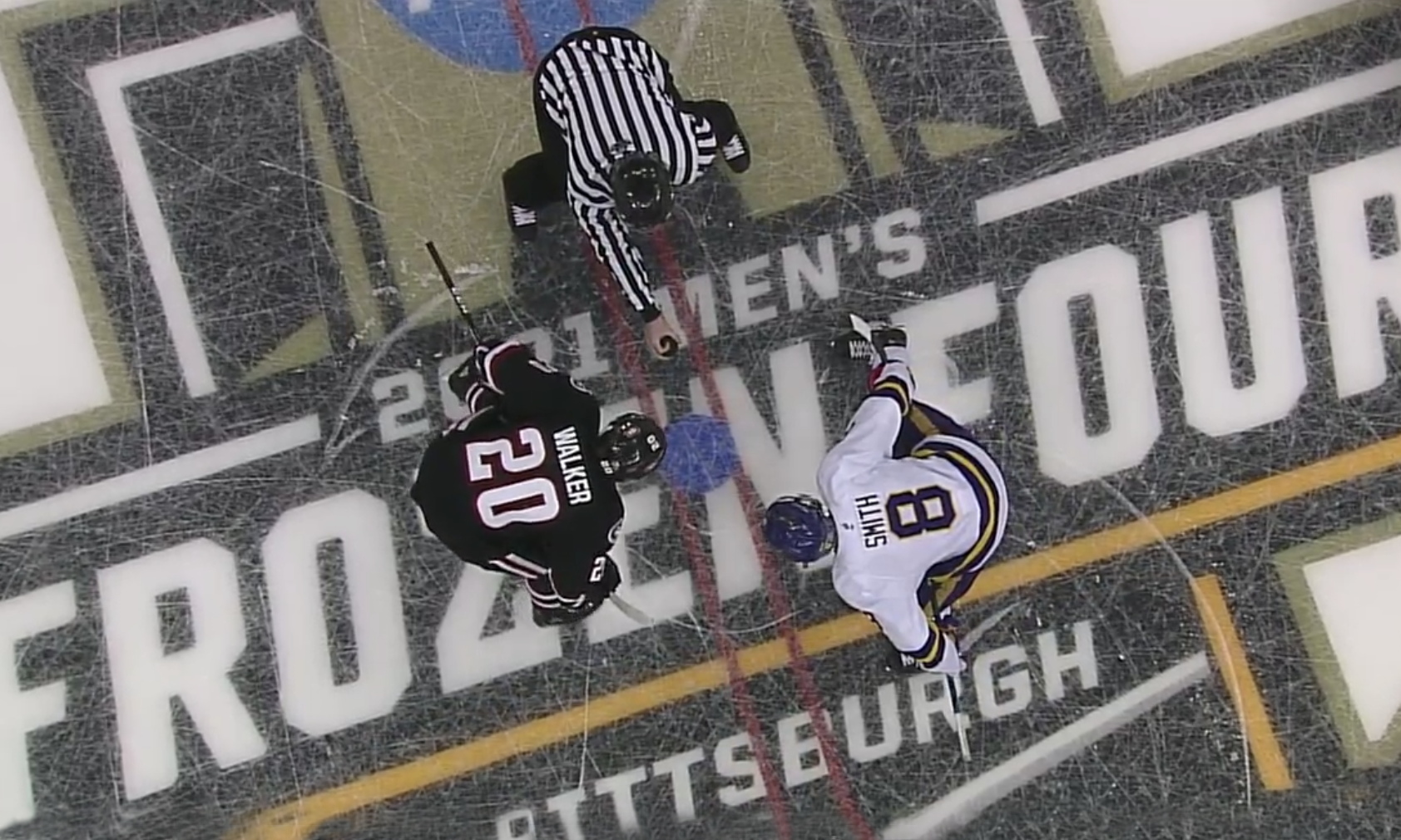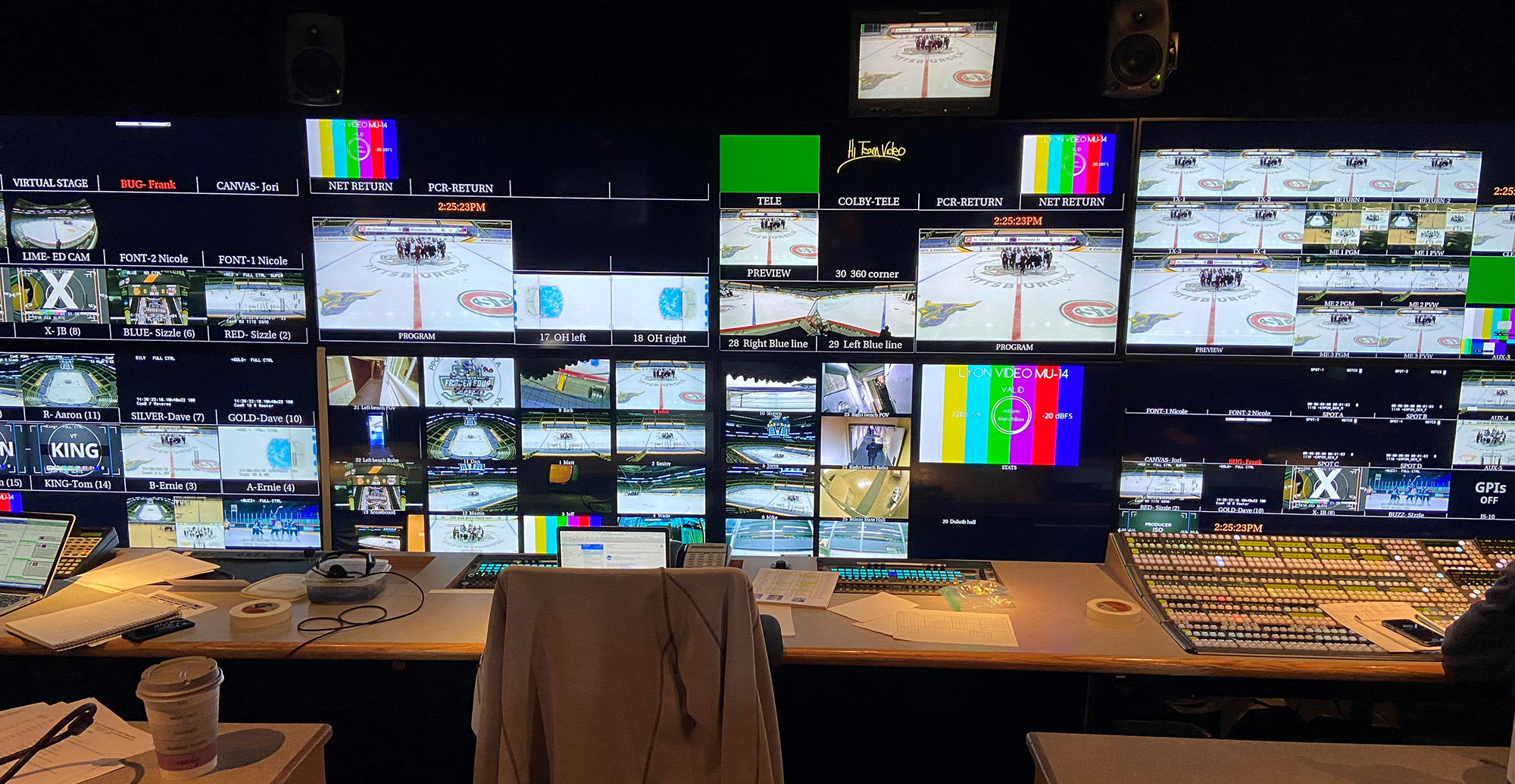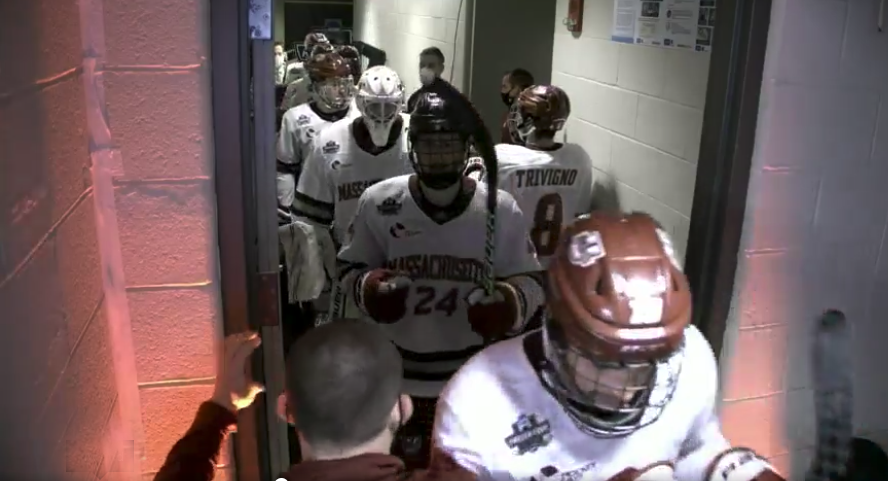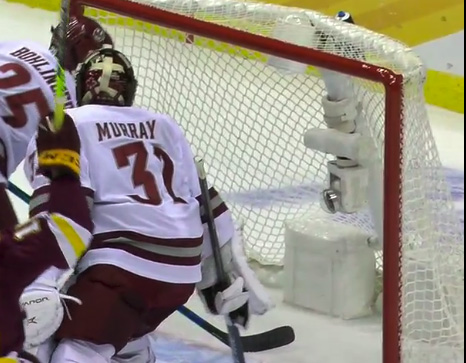ESPN Deploys Arsenal of Robos, POVs, C360 Cameras for NCAA Men’s Frozen Four
Safety protocols, changing capacity rules complicate setup
Story Highlights
After becoming one of the first pandemic-related cancellations on the sports calendar in 2020, the NCAA Men’s Frozen Four is back on the ice this year in Pittsburgh. Since the event is certainly different from previous iterations, with attendees at only 25% capacity at the PPG Paints Arena, ESPN has rolled out one of its most robust production complements ever — including C360 cameras and an army of robos — in an effort to create a compelling atmosphere for viewers at home.

After two epic semifinals last night, ESPN’s Frozen Four coverage culminates on Saturday with UMass–St. Cloud State.
“I think, with the amount of cameras and unique views we have this year, that we didn’t necessarily have in the past, we’ve come up with a really sound game plan that’s going to make this one stand out during a very difficult time,” says Andrew Green, senior managing producer, ESPN. “We knew our coverage would have to change, with [fewer] fans there and the [safety] protocols, so we decided to supplement our coverage and create our own atmosphere with additional unmanned cameras and audio aspects. We think that it will give us more access and create something special this year.”
With UMass upsetting Minnesota Duluth and St. Cloud State beating Minnesota State, the Minutemen are set to take on the Huskies for the national championship on ESPN Saturday night.
On the Ice: Unmanned Cameras Play Key Role in ESPN’s Coverage
ESPN has rolled out a total of 28 cameras at PPG Paints Arena (up significantly from 16 in 2019). Of those, the game-coverage cameras include nine manned cameras (seven hards and two handhelds), two of which are super-slo-mo; five robotic cameras, three of which are super-slo-mo; in-net cameras in both goals; and C360 cameras providing 180-degree perspectives on both blue lines.

ESPN has rolled in Lyon Video Lyon 14 mobile unit for its Frozen Four production this year in Pittsburgh.
With ESPN’s access to the ice and locker rooms limited by COVID safety protocols, ESPN has added robos in the back hallways to cover the teams coming onto and leaving the ice.
“We are excited to have those hallway cameras and more unmanned cameras all over the arena,” says Green. “Those additional cameras will give us a lot more access without having to physically send people back there.”
On the audio side, ESPN is tweaking its microphone placement around the rink to capture the maximum amount of in-game sound possible.
“Just naturally, with the reduced amount of fans, we’re going to get a lot more sounds of the game that we wouldn’t necessarily have gotten in years past,” says Green. “We’re also being strategic with some microphone placement to get more of those [game] sounds, [which] come through a lot differently this year with that reduced capacity.”
In addition, PPG Paints Arena is playing pre-recorded tracks from each school’s band in the moments they would traditionally have played during the game. Although these tracks aren’t running through ESPN’s audio board in the truck, they can be heard prominently in the broadcast sound.
Commentators John Buccigross and Barry Melrose are calling the game from the traditional TV booth at PPG Paints Arena (socially distanced and with advanced air purifiers installed in the booth). Meanwhile, reporter Colby Cohen and an A2 (among the few ESPN staffers in the NCAA’s Tier 1 group with players and coaches) are positioned in the lower stands socially distanced from both the team benches and the fans in attendance.
“With our safety protocols and the requirement of a distance between our personnel and fans, it has been a balancing act [to position talent],” says Green. “but we were able to work through it.”
In the Compound: Extra Truck for Social Distancing

Without access to locker rooms this year, ESPN deployed several robos in the back hallways of PPG Paints Arena.
ESPN has rolled out Lyon Video Lyon 14 production truck as its A unit and Lyon B5 as the B unit, along with a flex unit to provide additional seating. Several graphics and EVS replay positions have been moved to the flex unit to allow social distancing within the A and B units.
“Social distancing in a truck is challenging, because trucks are purpose-built to [accommodate] 14 or 15 people, but we can get only eight or nine in there,” says ESPN Operations Manager Tommy Mitchell. “It becomes very challenging on the engineering side when pieces that were in one truck need to be moved to another. It requires more time to get done, and time isn’t always on our side as you get closer to event day. But we can give everyone a safe working environment while also still delivering the same level of show we’ve delivered in the past.”
ESPN will also bring in a generator from Saunders Electric for the Championship Game to ensure redundancy.
The COVID Factor: Revamped Setup Schedule, Moving Target on Attendance

Reporter Colby Cohen (left), one of the few ESPN staffers to have Tier 1 access, conducts socially distanced interviews with players.
In addition to the NCAA’s tiered safety system to avoid intermixing players/coaches (Tier 1) and production crew (Tier 2), ESPN is following its in-house corporate testing policy, which requires all personnel to pass a COVID test prior to traveling and again onsite before receiving their credential. Under the NCAA’s tiered system, the ESPN team was barred from the rink during practices each day, forcing the network to adjust its typical setup schedule and arrive a full day early in Pittsburgh.
“It certainly has made things a little bit more challenging and has added a few days [of setup] to this week for us,” says Mitchell. “When practices are going on with players and coaches on the ice, Tier 2 people cannot be ringside. So we did a lot of our ice setup Tuesday into Wednesday night to avoid the practices that take place pretty much all day. Then we are concentrated on the higher-up cameras, the booth, and the truck setup while practices are going on.”

ESPN commentators John Buccigross (left) and Barry Melrose are socially distanced in the TV booth at PPG Paints Arena.
In addition, the cap on the number of fans in the stands went from zero to 15% to 25% of seating capacity during ESPN’s planning for the NCAA Frozen Four over the past few months, causing further headaches for the operations team.
“We started planning with one level of fan attendance, and it changed twice,” says Mitchell. “Obviously, that’s a good thing — we want people to come back to the event, and the more fans the better — but, anytime those things change, we have to run our plan back through all of our safety protocols. Whether it’s booth positions, camera positions, crew positions, cable runs — it just makes our job a little bit more challenging to make sure we check all the safety boxes and keep everyone safe.”
Hockey on the Brain: ESPN Preps for NHL’s Arrival
This year’s Frozen Four is unlike any before it for ESPN — not just because of the added challenge of producing the event amid a pandemic but also because it marks the broadcaster’s first hockey production since the announcement of its new rights deal with the NHL. With plenty of pro hockey on the horizon, this year’s Frozen Four has taken on a special significance.
“Hockey has been on the forefront of a lot of people’s minds at ESPN of late,” says Green. “There’s a lot of excitement around this event [internally] with the NHL coming back to our network. And I think that has created even more buzz for this tournament.
“It has been a massive undertaking,” he continues, “and I couldn’t be more thankful for our team and proud of them for getting us to this point.”

